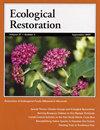Seasonal Shifts in Diversity and Composition of a Tallgrass Prairie Restoration Have Implications for Sampling Time
IF 1.1
4区 环境科学与生态学
Q2 ECOLOGY
引用次数: 1
Abstract
ABSTRACT Restorations change across the growing season. Because of this, the point in the season that a restoration is sampled may affect the conclusions reached based on the sample. In this study, we explore seasonal changes in a prairie restoration experiment in eastern Kansas and investigate how these changes affect observed composition, biodiversity, and the effects of seeding density treatment on the plant community based on when, and how completely, vegetation is sampled. Free State Prairie was established in 2014 to test the effects of forb seeding density on forb establishment, diversity, and restoration success. We compared absolute cover data collected in early June and early September 2019 to each other and to combined data. We found changes in both composition and biodiversity from early-to-late in the season. Sown forbs decreased in cover and richness, while sown grasses increased in cover and richness. Nonsown species did not change in cover but decreased in richness. Neither individual sample fully represented the overall composition or biodiversity of the community. We detected a significant negative effect of forb seeding density on diversity in June, and with combined data, but not in September. As sampling time can affect both broad patterns of composition and diversity and observed results of establishment and management techniques, sampling multiple times in a year will provide the fullest and most accurate picture of the community. When multiple samples are impractical, sampling time should be selected carefully based on the phenology of the restoration and the variables of interest.高草草原恢复多样性和组成的季节变化对采样时间的影响
摘要修复会随着生长季节的变化而变化。正因为如此,在季节中对修复进行采样的点可能会影响基于样本得出的结论。在这项研究中,我们探索了堪萨斯州东部草原恢复实验中的季节变化,并调查了这些变化如何影响观测到的成分、生物多样性,以及基于何时以及如何完全采样植被,种子密度处理对植物群落的影响。自由州草原于2014年建立,旨在测试禁种植物播种密度对禁种植物建立、多样性和恢复成功的影响。我们将2019年6月初和9月初收集的绝对覆盖率数据相互比较,并与综合数据进行比较。我们发现,从季节的早期到晚期,成分和生物多样性都发生了变化。播种的杂草覆盖率和丰富度降低,而播种的草覆盖率和丰度增加。非own物种的覆盖率没有变化,但丰富度下降。两个样本都不能完全代表群落的整体组成或生物多样性。我们在6月份和综合数据中发现了forb播种密度对多样性的显著负面影响,但在9月份没有。由于采样时间既会影响组成和多样性的广泛模式,也会影响建立和管理技术的观察结果,因此一年中多次采样将提供最全面、最准确的社区情况。当多个样本不切实际时,应根据修复的酚学和感兴趣的变量仔细选择采样时间。
本文章由计算机程序翻译,如有差异,请以英文原文为准。
求助全文
约1分钟内获得全文
求助全文
来源期刊

Ecological Restoration
Environmental Science-Nature and Landscape Conservation
CiteScore
1.70
自引率
12.50%
发文量
24
期刊介绍:
Ecological Restoration is a forum for people advancing the science and practice of restoration ecology. It features the technical and biological aspects of restoring landscapes, as well as collaborations between restorationists and the design professions, land-use policy, the role of education, and more. This quarterly publication includes peer-reviewed science articles, perspectives and notes, book reviews, abstracts of restoration ecology progress published elsewhere, and announcements of scientific and professional meetings.
 求助内容:
求助内容: 应助结果提醒方式:
应助结果提醒方式:


